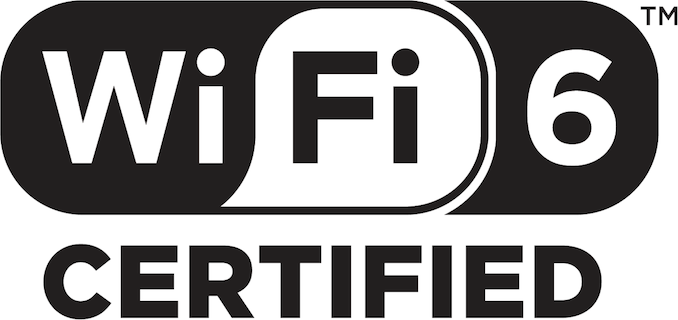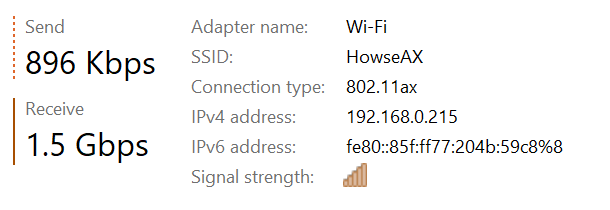AT 101: Wi-Fi 6 And Why You Want It
by Brett Howse on February 12, 2020 8:00 AM ESTTo The Future
If the question is do you need Wi-Fi 6, the answer is most assuredly “maybe”. The performance improvements are substantial, but really rely on a very strong signal to get the most data throughput. Most of the new features of Wi-Fi 6 focus on the influx of devices to the standard, and dealing with many devices connected to the same access point, or devices trying to share spectrum when connected to different access points.
The addition of Orthogonal Frequency Division Multiple Access to the Wi-Fi 6 standard will likely be the most impactful change to this revision. It will allow access points to carve up their channels into smaller slices, allowing more devices to communicate at the same time with less overhead. Each device will lose out on peak throughput, but the reduced latency should help a lot, especially in very dense environments. It should help with excessive overhead on the network layer when multiple devices are sending many small packets at once, which is a very common scenario, especially in an office or stadium situation.
Multi-User MIMO was in the Wi-Fi 5 specification as an optional implementation, and as such it did not really take off. Wi-Fi 6 should make this more prevalent, and also adds support to the MU-MIMO on the uplink, not just the downlink side. This will increase the capacity of access points for higher-speed use cases, but MU-MIMO did not get a lot of traction in Wi-Fi 5 so we will have to see how much adoption it gets in Wi-Fi 6.
The wider 160 MHz channels will offer significantly more throughput in the home environment, as we saw in our performance tests. As with the 1024-level QAM though, to see the biggest benefit you will need a strong signal. The vast majority of home networking is still limited to 1 Gigabit Ethernet, which puts Wi-Fi 6 into somewhat of an awkward spot, since it can transfer faster than most wired home networks, but even so, that is still a significant improvement over Wi-Fi 5 which would cap out around 600 Mbps on the best Wi-Fi adapters. If you work with a lot of large files, and you prefer to use Wi-Fi instead of the more consistent, yet cumbersome Ethernet, there’s still a nice boost to be had.
The future looks strong for Wi-Fi, and the Wi-Fi Alliance has made some excellent revisions to their standard to help improve Wi-Fi for the next generation of devices. As with any standards change, the impacts will not be seen right away. Both the access point, and the client need to be leveraging the new standard for the improvements to be noticeable. We’ve already seen the latest generation of smartphones start to offer Wi-Fi 6, and there’s been some movement in the PC space as well with Intel’s Project Athena. Anyone looking at a new router today should certainly opt for a Wi-Fi 6 model, but there’s likely not a major need for most people to move from Wi-Fi 5 access points right away. If you live in a heavily congested wireless area, the advantages of features like BSS coloring and Spatial Frequency Reuse should help out in those scenarios, but for people looking at purely performance, Wi-Fi 6 somewhat runs into a wall of its own making, since it can now transfer at over Gigabit speeds on a typical 2x2:2 connection. But who are we to question performance?












149 Comments
View All Comments
Makaveli - Wednesday, February 12, 2020 - link
True but using a 4 year old article in this example failed. In 2016 I was already using a Docsis 3.0 250/20 Cable connection. Yet that article shows 16mbps as the national average..By 2017 I was on a Docsis 3.1 500/20 cable connection and now in 2019 I moved up to a 1Gbps/750Mbps fiber connection.
The majority of cable providers in the US are still using Docsis 3.0 modems and within the last year or you are finally starting to see docsis 3.1 modems mostly because Comcast started to push them out.
triphoppingman - Wednesday, February 12, 2020 - link
"True but using a 4 year old article in this example failed. In 2016 I was already using a Docsis 3.0 250/20 Cable connection. Yet that article shows 16mbps as the national average"Anecdote vs Aggregated data? I know which one I prefer.
Makaveli - Wednesday, February 12, 2020 - link
haha well played sir.However most of the users on that cable ISP in canada I was using went thru the same Docsis 3.0-3.1 progression and that is one the biggest Cable ISP in Canada. And everyone sent from 250mbps connection to the eventual 3.1 Docsis with 1Gbps cable. So the numbers are bigger than just my example.
rrinker - Wednesday, February 12, 2020 - link
I have 350 down/15 up which is plenty fast for streaming and even downloading DVD size games 'updates', and I am not data capped.I can get up to 1Gb down, but I don;t want to pay more. I still pay the same as I did when I moved in when it was 200Mb down, speed has been upped 3 times with no change in the bill.
triphoppingman - Wednesday, February 12, 2020 - link
No, frankly, I don't trust an anonymous Internet poster. Not when the facts are not on your side. How is the weather up there?808Hilo - Wednesday, February 12, 2020 - link
The social trust index in the US is half of that in Canada. We made us 320 million sociopaths, So no matter what you say - the Murican will tell you that everything is better here. The murican actually believes this against better knowledge - while the facts tell that the american project is now the first and foremost failed state on this planet. Yep, internet here means gouging, unkept promises, lousy service at elevated pricing. Its ridiculously bad for the big majority. No dont trust the voice of an murican on the internet - and we should build a higher wall around the US - to keep them in.Makaveli - Wednesday, February 12, 2020 - link
What facts?AdhesiveTeflon - Wednesday, February 12, 2020 - link
Not gonna lie, Canada's cellphone coverage is phenomenal compared to anything in the US. I can be in the middle of the trans-canadian highway in Saskatchewan and still have at least 3G. I go 30 miles outside of chicago and I don't have any signal.JKflipflop98 - Thursday, February 13, 2020 - link
I get 1gig speeds from comcast for $45 a month over cable here in Oregon.flyingpants265 - Wednesday, February 12, 2020 - link
50% of the entire "Canada" lives pretty close to Toronto.It's kinda rare to have somewhere that won't get 50mbps as a minimum. Places in big cities get 1gbit+. No data caps either.